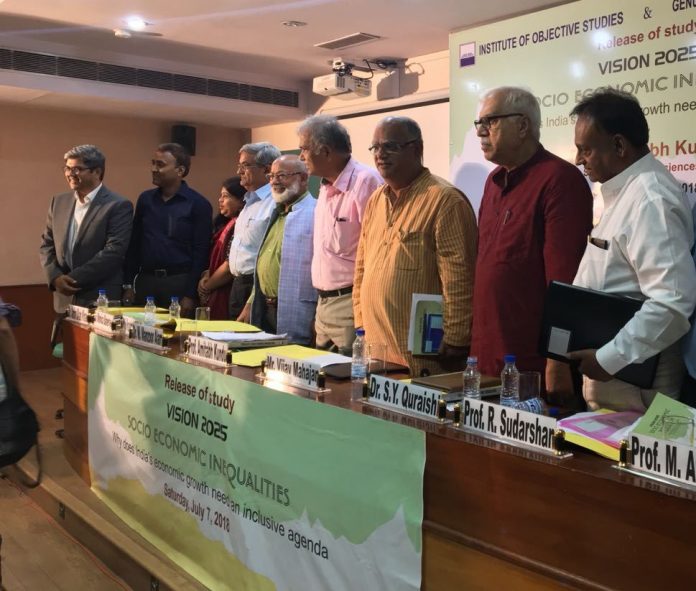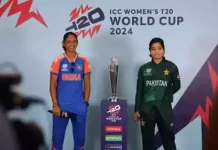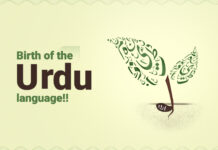Amir Ullah Khan and Abdul Azim Akhtar , Mr. Vijay Mahajan, Prof. Naushad Ali Azad , Ms. Monica Banerjee, Professor Amitabh Kundu , Dr. S Y Quraishi, Dr. Mohammad Manzoor AlamProf. Sudarshan Ramaswamy during the launch of the study. ( From Left to Right) www.siyasat.net
89 per cent of Muslims face challenges as a minority community in India
By Abdul hafiz lakhani New Delhi
VISION 2025 SOCIO ECONOMIC EQUALITIES– a depth study about Indian Muslims was released recently by publisher Institute of Objective Studies, New Delhi. The book is written and edited by Dr Amir Ullah Khan and Dr. Abdul Azim Akhtar
The study finds that 89 per cent of Muslims face challenges as a minority community. A whopping 86 per cent of the respondents were not aware of the government schemes.Around 44 per cent of the respondents were not aware of the Sachar Committee report.
The Study shows that Muslims, with 14.2 percent population according Census 2011 are lagging behind in all parameters of development index. The total sample size for the study was 3400, which included both Muslim and Non-Muslim respondents in 13 states including West Bengal, Assam , Gujarat, Telangana,Tamil Nadu , Karnataka, Jammu and Kashmir.
Distinguished Economist Professor Amitabh Kundu released the report VISION 2025: Socio Economic Inequalities at Jamia Millia Islamia’s CIT Conference Hall. He said that the study by Amir Ullah Khan and Abdul Azim Akhtar was the need of the hour to know issues of concern. He said that the book captures the data and research to showcase the pitiable condition of the Muslims, who remain at the bottom of the society from all aspects of development. Prof. Kundu said that the study raises several pertinent questions with regard to social and economic aspects of Indian society.
Economist Prof. Amir Ullah Khan, said that Indian Muslims need better education, access to health and credit to be part of the development. Mr. Vijay Mahajan, CEO, Rajiv Gandhi Institute of Contemporary Studies, said the report would help in understanding the changes after the Sachar Committee report. Prof. Naushad Ali Azad lauded the efforts of the Institute of Objective Studies and authors in bringing out the report. Ms. Monica Banerjee, Director National Foundation of India, in her address that the budget allocation for the Muslims in state as well centre was very low, and an indicator of the government’s apathy towards the community. She said that even west Bengal which has 28 per cent Muslims just spend less than 2 per cent on them.
Prof. Sudarshan Ramaswamy, Dean Jindal School of Government and Public Policy, in his address recalled the importance of such reports in understanding the human development, which was initiated by Amartya Sen and Mahboobul Haque. He hoped that the gaps in the development would be addressed by the policy makers.
Dr. S Y Quraishi, ,Chancellor IILM University and Former Chief Election Commissioner of India described the entire debate of Muslim population rise as myth propagated by vested interests. He called upon to give Muslim girls education and jobs, and the fertility rate would be further reduced. He provided evidence from Shariat in support of family planning, and said the practice was started first by Muslims with innovative methods and practices. He said that he never came across a Muslim who had even three wives, and people spread rumours of four wives. He provided figures to make the point that polygamy was a practice among tribals, who were not Muslims.
Dr. Mohammad Manzoor Alam , IOS Chairman in his presidential remarks deplored the existing conditions, and stressed the need of such study to present the true picture. He said that despite various sacrifices by Muslims in 1962, 1965 and 1971 the community has been pushed to the margins. He lamented that conditions like 1947 prevailed in the country, and even we are not allowed to express our anguish and helplessness. He hoped that the study will help in understanding the issues of the community.
The study done by Prof. Amirullah Khan and Dr. Abdul Azim Akhtar is a major study on the Muslim community after the Sachar Committe and Kundu Committe reports. Akhtar said, ‘Perhaps for the first time, we have made an attempt to study the conditions from the data and sources which did not exist. We went to various cities to know the pulse of the Muslims through workshops and seminars and they were happy to share their stories. Most of the people who shared their views were young’.
About the Book
In today’s world and times, it is important to look at what the vision for Indian Muslims should look like. Formulating a vision statement for an entire community is an onerous responsibility and therefore needs to be done with great care and wide consultations across the country to garner thoughts on what Muslims in India today face and what the country holds out for them in the next ten years. The study, which was coordinated by Dr. Amir Ullah Khan and Dr. Abdul Azim Akhtar, is divided in five parts, each one focusing on gathering various strands of insight and information, and include a nationwide survey, state level workshops, national conference, interviews with people, and research papers from experts and researchers. The attempt is bring together views from all sections of society.
Professor Amitabdh Kundu on the Vision 2025: “The report has done an excellent job in focusing on these conditions and highlighting the critical explanatory factors behind disparity and deprivation with empirical rigour. A development strategy envisioning a modern, vibrant and inclusive India must address these issues with conviction and determination.”
EXCERPTS FROM THE BOOK:
Prof. Amitabh Kundu in his forward says, ‘A vision of India 2025, for having relevance in policy domain, too, must put forward a perspective of development interventions to mitigate the alarming inequalities in the system and propose measures for ameliorating the conditions of the poor and vulnerable. Any analysis of recent data would demonstrate that Muslims constitute the largest majority in both the categories’.
Economist Amir Ullah Khan in his Preface, says, ‘This large piece of work tries to bring together various views and debates on the subject of deprivation and discrimination of Muslims’,
Historian Abdul Azim Akhtar says, ‘The study despite its limited resources and access to information, being a non-government initiative attempts to go beyond the existing data and figures. We have tried to included voices of people who are either working in the field or are directly witness to the areas of education, health, security, employment and political representation. We try to fill the gaps and also provide ample scope for further research in the field’.
In the interview Section, there is important interview with late Justice Rajinder Sachar:
Justice Rajinder Sachar was not sure about the changes over the last few years. He defended the government’s decision to appoint the committee and said, ‘Many people argue against Sachar Committee. Why you did this? Why did not you study about Hindus? This is not about Muslims, it actually compares the position of Muslims with other sections of society’. He considers communalism, inequality, education and population figures as challenges for the Muslims. He called for deployment of Muslim officers in Muslim-dominate areas. He also called for better ration of Muslims in Police forces to ensure security and safety for Muslims. On the issue of Babri Masjid, he said ‘Many People said that Muslims should move on…what move on? According to me, whole land has to be given to Muslims. You cannot hurt psychology of such a deep nature’.
BACKGROUND
Incomes: Between 1999 and 2011, the least change in per capita incomes was seen among the Muslims.
Employment- The reservation policy was lopsided; Education, STs and Muslims, top the list of large populations that have never attended any school;
Women: A majority of rural Muslim women are engaged in tailoring activities; The study found that Muslim women are more aware of family planning practices and contraception methods than others.; Housing: A large percentage of Muslims live in rented accommodation.
Credit: The problems with credit availability were reported by the most number of people.
VISION
Editors of the study Amir Ullah Khan and Abdul Azim Akhtar says, ‘We envision an India in 2025, where all Muslims are assured of, and have access to, equitable and inclusive growth through public and private service delivery and are able to pursue their aspirations with the optimal health, education, wellbeing and quality of life’.
Education- There is a special need to improve quality of education in schools. Successful interventions like the Gyan Shala or the ENH Foundation’s initiatives can be brought in to help primary schools achieve quality education.
Both Public and Private Universities must recruit larger number of Muslims in their higher education programs.
Health- Improvement of public health facilities by setting up more hospitals in the Muslim dominated localities is a necessity.
Entrepreneurship and employment- Most Muslims are engaged in self-employment activities and their participation in agricultural activity is very low. So, policies for employment generation within the Muslims should target non-agricultural sectors.
Housing- Government should ensure equity in housing. So, 20% of houses in urban areas and 5% in rural areas should be allocated to Muslims.
Credit and Financial Inclusion- There shall be group lending approach to Muslims who mostly work in informal sectors and seek petty loans.
Government employment- To overcome the under-representation of Muslims in administrative services like IAS, IPS and IFS, attempts should be made to fill the gap through promotion quota from cadres in state service.
“Muslims across the country have had lesser exposure and access than the average Indian to primary education, healthcare and credit, and have often fallen prey to discrimination and ethnic violence. Issues pertaining to inadequacy in education, lack of institutional support, weak economic conditions, lack of employment and employability, cultural gap, inadequate representation in administrative bodies, lack of security, lack of adequate reservations, etc. have cropped up time and again in recent history”



































